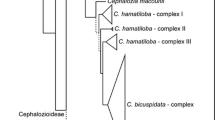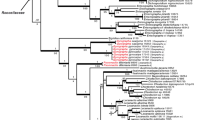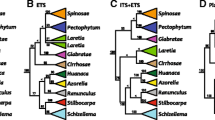Abstract
Phylogenetic relationships within the Parmeliaceae are analysed cladistically on the basis of DNA characters from partial β-tubulin, partial glyceraldehyde-3-phosphate dehydrogenase (GAPDH) and ITS sequences. 100 taxa representing 73 of the 88 genera currently recognised are included in the analyses. Eight monophyletic groups including two or more genera were identified in the tree calculated from the combined data matrix. Three of the groups cover almost half of the species of the family. The largest and strongest supported group includes seven genera with their distribution centres in the Southern Hemisphere: Almbornia, Chondropsis, Karoowia, Namakwa, Neofuscelia, Xanthomaculina and Xanthoparmelia. The second group is a clade of four essentially tropical genera: Concamerella, Flavoparmelia, Parmotrema and Rimelia. The third large group with strong support is the core of cetrarioid lichens, distributed primarily in cold areas of the Northern Hemisphere. The genus Parmelia sensu Hale is not closely related with most of its segregates. One new combination, Cetrariella commixta, is proposed. Coelopogon abraxas is reported from South America for the first time.
Similar content being viewed by others
References
Acharius E (1803) Methodus lichenum. Stockholm. 394 pp.
Acharius E (1810) Lichenographia universalis. Göttingen. 689 pp.
Adanson M (1763) Familles des Plantes. Paris.
Brodo IM, Sharnoff SD, Sharnoff S (2002) Lichens of North America. Yale University Press, New Haven. 795 pp.
Brodo IM, Hawksworth DL (1977) Alectoria and allied genera in North America. — Opera Botanica 42: 1–164.
Brusse FA, Kärnefelt I (1991) The new Southern Hemisphere lichen genus Coelopogon (Lecanorales, Ascomycotina), with a new lichen species from southern Africa. — Mycotaxon 42: 35–41.
Clauzade G, Roux C (1985) Likenoj de okcidenta Europo. Royan, France. 893 pp.
Coppins BJ (2002) Checklist of lichens of Great Britain and Ireland. British Lichen Society, London.
Crespo A, Blanco O, Hawksworth DL (2001) The potential of mitochondrial DNA for establishing phylogeny and stabilising generic concepts in the parmelioid lichens. — Taxon 50: 807–819.
Crespo A, Cubero OF (1998) A molecular approach to the circumscription and evaluation of some genera segregated from Parmelia s. lat. — Lichenologist 30: 369–380.
Culberson WL, Culberson CF (1965) Asahinea, a new genus in the Parmeliaceae. — Brittonia 17: 182–190.
Culberson WL, Culberson CF (1968) The lichen genera Cetrelia and Platismatia (Parmeliaceae). — Contributions from the United States National Herbarium 34: 449–558.
Divakar PK, Upreti DK (2003) New species and new records of Parmotrema (Parmeliaceae) from India. — Lichenologist 35: 21–26.
Divakar PK, Upreti DK, Elix JA (2001) New species and new records in the lichen family Parmeliaceae (Ascomycotina) from India. — Mycotaxon 80: 355–362.
Eliasaro S, Adler MT (1997) Two new species and new reports in the Parmeliaceae sensu stricto (lichenized Ascomycotina). — Mycotaxon 63: 49–55.
Elix JA (1979) A taxonomic revision of the lichen genus Hypogymnia in Australasia. — Brunonia 2: 175–245.
Elix JA (1993) Progress in the generic delimitation of Parmelia sensu lato lichens (Ascomycotina: Parmeliaceae). — Bryologist 96: 359–383.
Elix JA (1995) New species in the lichen family Parmeliaceae (Ascomycotina) from Australasia and Oceania. — Mycotaxon 56: 231–241.
Elix JA (1996) New species in the lichen family Parmeliaceae (Ascomycotina) from Australasia and Malaysia. — Mycotaxon 59: 407–417.
Elix JA (1997) Further new species in the lichen family Parmeliaceae (Ascomycotina) from Australasia. — Mycotaxon 65: 481–491.
Elix JA (2003a) New species and new records of Xanthoparmelia (lichenized Ascomycotina, Parmeliaceae) from western Australia. — Lichenologist 35: 291–299.
Elix JA (2003b) The lichen genus Paraparmelia, a synonym of Xanthoparmelia (Ascomycota, Parmeliaceae). — Mycotaxon 87: 395–403.
Elix JA, Hale ME (1987) Canomaculina, Myelochroa, Parmelinella, Parmelinopsis and Parmotremopsis, five new genera in the Parmeliaceae (lichenized Ascomycotina). — Mycotaxon 29: 233–244.
Elix JA, Hale ME, Verdon D (1986) Canoparmelia, Paraparmelia and Relicinopsis, three new genera in the Parmeliaceae. — Mycotaxon 27: 372–383.
Elix JA, James P (1992) Hypogymniaceae. In: Flora of Australia 54, lichens–Introduction, Lecanorales 1, p. 200.
Elix JA, Louwhoff SHJJ, Molina M del C (2000) Two new species of Xanthoparmelia (lichenized Ascomycotina, Parmeliaceae) from Australia containing norlobaridone. — Mycotaxon 74(2): 499–503.
Elix JA, Schumm F (2001) A new species and new records in the lichen family Parmeliaceae (Ascomycotina) from the Philippines. — Mycotaxon 79: 253–260.
Eriksson OE, Hawksworth DL (1985) Outline of the ascomycetes-1985. — Systema Ascomycetum 4: 1–79
Eriksson OE, Hawksworth DL (1991) Outline of the ascomycetes-1990. — Systema Ascomycetum 9: 39–271.
Eriksson OE, Hawksworth DL (1998) Outline of the ascomycetes-1998. — Systema Ascomycetum 16: 83–296.
Eschweiler FG (1824) Systema lichenum, genera exhibens rite distincta, pluribus novis adaucta. Norimbergiae. 26 pp
Esslinger TL (1977) A chemosystematic revision of the brown Parmeliae. — Journal of the Hattori Botanical Laboratory 42: 1–211.
Esslinger TL (1978) A new status for the brown Parmeliae. — Mycotaxon 7: 45–54.
Esslinger TL (1981) Almbornia, a new lichen genus from South Africa. — Nordic Journal of Botany 1: 125–127.
Farris JS (2000) xac. MS-DOS program for parsimony jackknifing. Distributed by the author.
Farris JS, Albert VA, Källersjö N, Lipscomb D, Kluge AG (1996) Parsimony jackknifing outperforms neighbour-joining. — Cladistics 12: 99–124.
Feuerer T (1998) E. Vainio’s contribution to the knowledge of the Parmeliaceae. — In: Marcelli M. P. and Ahti, T. (eds.): Recollecting Edvard August Vainio. CETESB, Sao Paulo, Brazil, pp. 47–60.
Galloway DJ (1992) Checklist of New Zealand Lichens. DSIR Land Resources Scientific Report, No. 26, DSIR Land Resources, Christchurch. 58 pp.
Gardes M, Bruns TD (1993) ITS primers with enhanced specificity for basidiomycetes. Application to the identification of mycorrhizae and rusts. — Molecular Ecology 2: 113–118.
Gilbert D (1993) SeqApp, a biological sequence editor and analysis program. Indiana University, Bloomington.
Guzow-Krzemiska B, Wegrzyn B (2003) A preliminary study on the phylogeny of the genus Melanelia using nuclear large sub-unit ribosomal DNA sequences. — Lichenologist 35: 83–86.
Hale ME (1974a) New combinations in the lichen genus Parmotrema Massalongo. — Phytologia 28: 334–339.
Hale ME (1974b) Bulbothrix, Parmelina, Relicina and Xanthoparmelia, four new genera in the Parmeliaceae. — Phytologia 28: 479–490.
Hale ME (1974c) Delimitation of the lichen genus Hypotrachyna (Vainio) Hale. — Phytologia 28: 340–341.
Hale ME (1976) Synopsis of a new lichen genus, Everniastrum Hale (Parmeliaceae). — Mycotaxon 3: 345–353.
Hale ME (1983) The biology of lichens. 3rd ed. Edward Arnold, London.
Hale ME (1984) Flavopunctelia, a new genus in the Parmeliaceae (Ascomycotina). — Mycotaxon 20: 681–682.
Hale ME (1985) Xanthomaculina Hale, a new genus in the Parmeliaceae (Ascomycotina). — Lichenologist 17: 255–265.
Hale ME (1986) Arctoparmelia, a new genus in the Parmeliaceae (Ascomycotina). — Mycotaxon 25: 251–254.
Hale ME (1987) Flavoparmelia, a new genus in the lichen family Parmeliaceae (Ascomycotina). — Mycotaxon 25: 603–605.
Hale ME (1988) Namakwa, a new lichen genus in the Parmeliaceae. (Ascomycotina). — Mycotaxon 32: 169–174.
Hale ME (1989) A monograph of the lichen genus Karoowia Hale (Ascomycotina: Parmeliaceae). — Mycotaxon 35(1): 177–198.
Hale ME (1989) A new lichen genus, Psiloparmelia Hale (Ascomycotina: Parmeliaceae). — Mycotaxon 35(1): 41–44.
Hale ME, Fletcher A (1990) Rimelia Hale & Flechter, a new lichen genus (Ascomycotina: Parmeliaceae). — The Bryologist 93(1): 23–29.
Hawksworth DL, Crespo A (2002) Proposal to conserve the name Xanthoparmelia against Chondropsis nom. cons. (Parmeliaceae). — Taxon 51: 807.
Hawksworth DL, James PW, Coppins BJ (1980) Checklist of British lichen-forming, lichenicolous and allied fungi. — Lichenologist 12: 1–115.
Henssen A, Jahns HM (1973 [‘1974’]) Lichenes. Eine Einführung in die Flechtenkunde. G. Thieme Verlag, Stuttgart.
Hillmann J (1936) Parmeliaceae. In: Rabenhorst, G. L: Kryptogamen-Flora von Deutschland, Österreich und der Schweiz. 2nd, Band 9. Die Flechten, Abteilung 5. Borntraeger∖Leipzig, pp. 1–309.
Hoffmann GF (1794) Plantae lichenosae. Descripto et Adumbratio plantarum e classe cryptogamica Linnai quae Lichenes dicuntur. II. Leipzig.
Huang X (1992) A contiguous assembly program based on sensitive detection of fragment overlaps. — Genomics 14: 18–25.
Kärnefelt I, Emanuelsson K, Thell A (1998) Anatomy and systematics of usneoid genera in the Parmeliaceae. — Nova Hedwigia 67: 71–92.
Kärnefelt I, Thell A (1992) The evaluation of characters in lichenized families, examplified with the Alectoriaceae and some genera in the Parmeliaceae. — Plant Systematics and Evolution 180: 181–204.
Keissler KV (1959) Usneaceae. In: Rabenhorst, G. L. Kryptogamen-Flora von Deutschland, Österreich und der Schweiz. 2nd, Band 5. Die Flecthen, Abteilung 4. Teil. Akademische Verlagsgesellschaft. Leipzig, pp. 481–640.
Kluge AG (1989) A concern for evidence and a phylogentic hypothesis of relationships among Epicrates (Boidae, Serpentes). — Systematic Zoology 38: 7–25.
Kroken S, Taylor JW (2000) Phylogenetic species, reproductive mode, and specificity of the green alga Trebouxia forming lichens with the fungal genus Letharia. — Bryologist 103: 645–660.
Kurokawa S, Moon KH (2000) New species and new records in Hypotrachyna (Parmeliaceae). — Bulletin of the Botanic Gardens of Toyama 5: 9–24.
Lindemuth R, Wirtz N, Lumbsch HT (2001) Phylogenetic analysis of nuclear and mitochondrial rDNA sequences supports the view that loculoascomycetes (Ascomycota) are not monophyletic. — Mycological Research 105: 1176–1181.
Louwhoff SHJJ, Elix JA (2000) Five new species in the lichen family Parmeliaceae (Ascomycotina) from Grande Terre, New Caledonia. — Mycotaxon 75: 195–203.
Lumbsch HT (1997) Bulbothricella amazonensis is a polysporous member of Bulbothrix (Parmeliaceae). — Mycotaxon 64: 225–228.
Lumbsch HT, Kothe HW, Elix JA (1988) Resurrection of the lichen genus Pleurosticta Petrak (Parmeliaceae: Ascomycotina). — Mycotaxon 33: 447–455.
Lumbsch HT, Wirtz N, Lindemuth R, Schmitt I (2002) Higher level phylogenetic relationships of euascomycetes (Pezizomycotina) inferred from a combined analysis of nuclear and mitochondrial sequence data. — Mycological Progress 1: 57–70.
Marcano V, Mohali S, Palacios-Prü E, Morales Méndez A (1996) The lichen genus Bulbothricella, a new segregate in the Parmeliaceae from Venezuela. — Lichenologist 28(5): 421–430.
Marcelli M, Ribeiro CH (2002) Twenty-one new species of Parmeliaceae (lichenized fungi) from southeastern Brazil. — Mitteilungen aus dem Institut für Allgemeine Botanik Hamburg 30–32: 125–155.
Marth C (1996) Anatomisch-morphologische Untersuchungen zum Merkmalsbestand der Parmeliaceae (Ascomycotina, Lecanorales). Dissertation, Fachbereich Biologie, Universität Hamburg. 290 pp.
Mattsson J-E (1993) A monograph of the genus Vulpicida (Parmeliaceae, Ascomycetes). — Opera Botanica 119: 1–61.
Mattsson J-E, Wedin M (1998) Phylogeny of the Parmeliaceae-DNA data versus morphological data. — Lichenologist 30: 463–472.
Mattsson J-E, Wedin M (1999) A re-assessment of the family Alectoriaceae. — Lichenologist 31: 431–440.
Myllys L, Högnabba F, Lohtander K, Thell A, Stenroos S, Hyvönen J (2004) Phylogenetic relationships of Ascomycota focussing on Stereocaulaceae based on simultaneous analysis of β-tubulin, GAPDH and SSU rDNA sequences (submitted ms.)
Myllys L, Lohtander K, Källersjö M, Tehler A (1999) Sequence insertions and ITS data provide congruent information on Roccella canariensis and R. tuberculata (Arthoniales, Euascomycetes) phylogeny. — Molecular Phylogeny and Evololution 12: 295–309.
Myllys L, Lohtander K, Tehler A (2001) b-tubulin, ITS and group I intron sequences challenge the species pair concept in Physcia aipolia and Physcia caesia. — Mycologia 93: 335–343.
Myllys L, Stenroos S, Thell A (2002) Use of glyceraldehyde-3-phosphate dehydrogenase and β-tubulin genes in phylogenetic studies of lichenized fungi. — Lichenologist 34: 237–246.
National Center of Biological information, NCBI, GenBank’s homepage: http://www.ncbi.nlm.nih.gov
Nimis PL (1993) The lichens of Italy. An annotated catalogue. Torino. 897 pp.
Nimis PL (1998) A critical appraisal of modern generic concepts in lichenology. — Lichenologist 30: 427–438.
Nixon KC, Carpenter JM (1996) On simultaneous analysis. — Cladistics 12: 221–242.
Nylander W (1860) Synopsis methodica lichenum I(2). Paris. 141–430, pl. v–viii, pp. v–xxi pp.
Nylander W (1866) Lichenes Lapponiae orientalis (= Prodromi Lichenographiae Scandinaviae Supplementum). — Notiser ur Sällskapet pro Fauna et Flora Fennica Förhandlingar 8: 101–192.
Nylander W (1869) Synopsis methodica lichenum. Paris. 1–64, pl. I pp.
Nylander W (1896) Les lichens des environs de Paris. P. Schmidt/Paris. 142 pp.
Persoh D, Rambold G (2002) Phacopsis-a lichenicolous genus of the Parmeliaceae. — Mycological Progress 1: 43–55.
Poelt J (1974) Classification. Appendix A. In: Ahmadjian, V. and Hale, M. E. (eds.). The lichens: pp. 599–632. Academic Press. New York & London.
Poelt J, Vezda A (1981) Bestimmungsschlüssel Europäischer Flechten. Ergänzungsheft II. Bibliotheca Lichenologica 16, J. Cramer, Vaduz. 390 pp.
Pooprang T, Boonpragob K, Elix JA (1999) New species and new records in the lichen family Parmeliaceae (Ascomycotina) from Thailand. — Mycotaxon 71: 111–127.
Purvis OW, Coppins BJ, Hawksworth DL, James PW, Moore DM (1992) The lichen flora of Great Britain and Ireland. Natural History Museum Publications & British Lichen Society, London. 710 pp.
Santesson R (1984) The Lichens of Sweden and Norway. Swedish Museum of Natural History, Stockholm. 333 pp.
Santesson R (1993) The lichens and lichenicolous fungi of Sweden and Norway. Lund. 240pp.
Satô M (1939) Parmeliales. In: Nakai, T. & Honda, M: Nova Flora Japonica. 5. Sanseido∖Tokyo & Osaka, 87 pp.
Satô M (1954) Enumeration of lichens collected in Tohoku-district, Japan. (1) Anziaceae and Baeomycetaceae. — Bulletin of the Yamagata University, Natural Sciences 3(2): 113–126.
Schaerer E (1850) Enumeratio critica lichenum Europaeorum. Bernae. 327 pp.
Scholz P (2000) Katalog der Flechten und flechtenbewohnenden Pilze Deutschlands. Schriftenreihe für Naturkunde Heft 31, 298 pp. Bundesamt für Naturschutz, Bonn-Bad Godesberg.
Sinha GP, Elix JA (2003) A new species of Hypogymnia and a new record in the lichen family Parmeliaceae (Ascomycota) from Sikkim, India. — Mycotaxon 87: 81–84.
Søchting U, Kärnefelt I, Kondratyuk S (2002) Revision of Xanthomendoza (Teloschistaceae, Lecanorales) based on morphology, anatomy, secondary metabolites and molecular data. — Mitteilungen aus dem Institut für Allgemeine Botanik Hamburg 30–32: 225–240.
Stenroos S, Hyvönen J, Myllys L, Thell A, Ahti T (2002) Phylogeny of the genus Cladonia s.lat. (Cladoniaceae, Ascomycetes) inferred from molecular, morphological, and chemical data. — Cladistics 18: 237–278.
Swofford DL (1998) PAUP: Phylogenetic analysis using parsimony, version 4.0b. Sunderland. Sinauer Associates.
Thell A (1995) A new position of the Cetraria commixta group in Melanelia (Ascomycotina, Parmeliaceae). — Nova Hedwigia 60: 407–422.
Thell A (1996) Anatomy and taxonomy of cetrarioid lichens. Summary of doctoral dissertation. Department of Systematic Botany, Lund University.
Thell A, Mattsson JE, Kärnefelt I (1995) Lecanoralean ascus types in the lichenized families Alectoriaceae and Parmeliaceae. — Cryptogamic Botany 5: 120–127.
Thell A, Stenroos S, Feuerer T, Kärnefelt I, Myllys L, Hyvönen J (2002) Phylogeny of cetrarioid lichens (Parmeliaceae) inferred from ITS-and b-tubulin sequences, morphology, anatomy and secondary chemistry. — Mycological Progress 1: 335–354.
Thon ML, Royse DJ (1999) Partial β-tubulin sequences for the evolutionary studies in the Basidiomycota. — Mycologia 91: 468–474.
Tomaselli R (1949) Schema sistematico dei licheni italiani e delle regioni limitrofe. Archivio Botanico 25 [Terza Ser. 9]: 3–47.
Tulasne L-R (1852) Mémoire pour sevir à l’historie organographique et physiologique des lichens. Annales des Sciences Naturelles; Botanique sér 3, 17: 5–128, 153–249 + pl. I–XVI.
Wedin M, Döring H, Mattsson J-E (1999) A multi-gene study of the phylogenetic relationships of the Parmeliaceae. — Mycological Research 103: 1185–1192.
White TJ, Burns T, Lee S, Taylor J (1990) Amplification and direct sequencing of fungal ribosomal DNA genes for phylogenetics. In PCR protocols: A guide to methods and applications. In: Innis M., Gelfand, J., Sninsky, J. & White, T., pp. 315–322, Academic Press, Orlando, Florida.
Wirth V (1995) Flechtenflora 2. Auflage, 661 pp. Ulmer Verlag Stuttgart.
Zahlbruckner A (1926) Lichenes. B. Spezieller Teil. In: Engler, A. (ed.): Die Natürlichen Planzenfamilien 2 Auf. 8: 61–270. Leipzig: W. Engelmann.
Zahlbruckner A (1930) Catalogus Lichenum Universalis 6: 1–618. Leipzig.
Author information
Authors and Affiliations
Corresponding author
Rights and permissions
About this article
Cite this article
Thell, A., Feuerer, T., Kärnefelt, I. et al. Monophyletic groups within the Parmeliaceae identified by ITS rDNA, β-tubulin and GAPDH sequences. Mycol Progress 3, 297–314 (2004). https://doi.org/10.1007/s11557-006-0100-1
Accepted:
Issue Date:
DOI: https://doi.org/10.1007/s11557-006-0100-1




